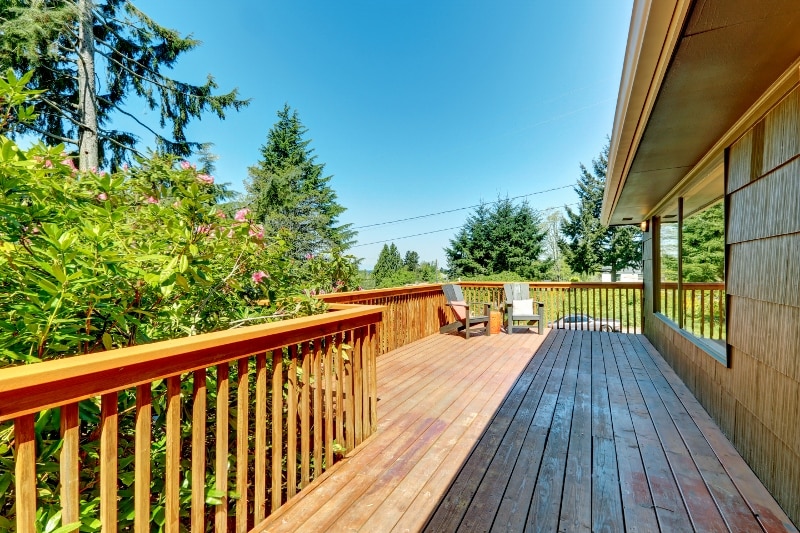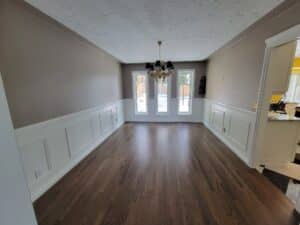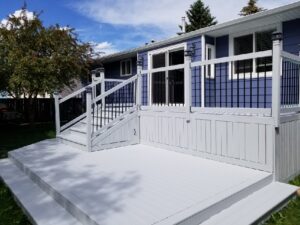
So you want to stain your fence, deck, and/or siding, but you are not sure where to start? Read these tips from Benjamin Moore in Edmonton and area: Click to see Benjamin Moore locations in Edmonton
Choose a stain to get the look you’re going for.
The first question that I usually start with when people come in is “what kind of look are you going for?”. This begins the discussion of whether they want to see wood grain or are fine with wood texture. This does confuse some people but we have come up with a pretty simple example, wood texture is the physical coarseness of the wood, and wood grain is the marbling color found on the wood (not unlike ribbons of caramel in ice cream, looks like that). For some people they enjoy the aesthetic appearance of the grain, and I will admit that it does look really sharp when well done; but this brings up the second question that we ask that may very well modify or change the first one.
Choosing solid stain vs. semi-transparent stain.
Solid stain is like paint, it covers completely and gives you the wood texture to enjoy, whereas semi-transparent stain gives you a slight color change to the wood but really emphasizes the wood grains. Problem is in Alberta with our weather you’re going to want some kind of longevity, and this is where the dilemma comes in.
Solid stain if properly done can last on average for 6-7 years (some longer, some shorter, on average though, 6-7 years), semi-trans stain on the other hand doesn’t build up as much of a protective film, meaning you might get at most 3 years on average before you have to do a fresh coat for maintenance.
Depending on the look you’re after for your deck, fence or siding, it might mean spending twice as much on product and labor to get the same kind of performance that a single application of solid can provide. (single application meaning that you only did the job once to get the same effect, still 2 coats though)
Best scenarios and practices to stain:
This brings us to the best scenarios and practices to stain, which matters a lot and can help with the durability part. The best time to stain is early in the morning (around 8 am or so during the summer when it gets really hot), when the wood is clean and dry, and after any and all scraping has been done, So let’s go into further detail about all of these points.
Temperature is really the one thing that really kills most stain jobs, when the surface is hot (put your hand on the wood, if its burning even though the air is cool that deck is too hot) it causes the paint or stain to essentially bake onto the wood, it doesn’t have the time to absorb into the surface and bond properly before hardening. You can tell this has happened to you because when you peel the flakes of your deck if they are glossy and smooth on the back, they baked onto the surface. Otherwise they wouldn’t be flaking off at all.
The surface has to be clean and dry. The reason that this matters is that wood absorbs moisture really well, and it can get dirt easily ingrained into the surface without being super visible. The issues that can occur from this is that the moisture needs somewhere to go and if you apply stain over top of wet wood it might bubble as the moisture looks for weak points to escape, or it might dry but flake off later because the water kept it from penetrating into the wood pores. The dirt needs to be removed because if you stain over top it might hold for a few years, but if the dirt lifts off its taking the paint with it. You can tell that this has happened because the dirt or contaminant is embedded in the backside of the flaking stain.
You need to scrape, not sand. You never need to sand your wood structures, taking a bladed scraper or equally effective tool your run it over the surface to distress the wood and remove anything that’s coming off, the idea being that anything that wants to come off will, leaving behind the parts of the coating that are well bonded to the surface.
How do you apply the stain? For decks the best application is to brush between boards and then roll the surface, ideally though your able to stain all sides of the boards before construction, but if not keep in mind that wood does wick up moisture and so any uprights near the ground will probably have more flaking issues as they pull moisture up into the wood and then as it tries to find a way out, generally by pushing off the coating, causing it to flake off.
Fences and siding can be rolled, but ideally are sprayed so that they have a smoother finish and are done relatively quickly.
So there you go, hopefully this information helps maybe clear some things up that you have experienced and wondered why it was happening, and plan for future home projects by timing them with the season to get the most out of your coatings and not spend as much on repeat maintenance.
For more information or to select a high quality stain, paint and supplies in Edmonton to start your outdoor project, contact Benjamin Moore!
**Special Limited Time Offer** Only valid at 4 location – click here to learn more.











